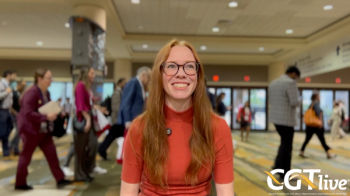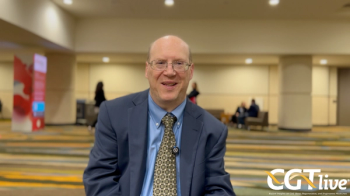
Patient Preference Among Key Considerations in Frontline RCC Therapy
Historically, patients with advanced renal cell carcinoma have had few treatment options, but several targeted agents and one immunotherapy, the checkpoint inhibitor nivolumab, have been approved within the past 5 years, considerably expanding the RCC treatment arsenal. In the frontline setting, targeted agents are often the go-to therapy.
Robert A. Figlin, MD
Historically, patients with advanced renal cell carcinoma (RCC) have had few treatment options, but several targeted agents and one immunotherapy, the checkpoint inhibitor nivolumab, have been approved within the past 5 years, considerably expanding the RCC treatment arsenal. In the frontline setting, targeted agents are often the go-to therapy.
Options include vascular endothelial growth factor (VEGF) inhibitors, an anti-VEGF monoclonal antibody, and mammalian target of rapamycin (mTOR) inhibitors (Table). Selecting from these treatments remains a challenge because guidelines on optimizing their use are still lacking.
During a recent OncLive Peer Exchange panel titled “Sequencing Therapies in Advanced Renal Cell Carcinoma” and moderated by Robert A. Figlin, MD, the panelists discussed the complexity of caring for patients with advanced RCC and described their frontline treatment approach, including when to start treatment, which agents they use, and when treatment needs to be switched.
To Treat or Not to Treat?
Although it is clear that considerable work still needs to be done on the RCC treatment front, there is also much to look forward to as studies continue to assess new treatment options and combination strategies, define optimal sequencing of treatments, and identify predictive biomarkers to improve treatment decision making.A key question that arises following a diagnosis of advanced RCC is when to start systemic treatment. Although most oncologists and patients want to start treatment immediately, a recently published phase II trial found that a small subset of patients might benefit from a period of active surveillance.1 “It’s about 10% of patients who can get away without [immediate] treatment,” said Elizabeth R. Plimack, MD, MS, who was one of the study’s lead investigators. She noted that patients with stable disease or slowly progressing disease might be good candidates for this approach, provided they are asymptomatic and otherwise healthy.
Daniel J. George, MD
“If you have patients who are symptomatic or have a lesion threatening a critical structure or organ, those are the people you’re going to want to start sooner,” she said. Daniel J. George, MD, added that patients with low-disease volume could also be considered for active surveillance.
Even when candidacy for active surveillance is clearly established, the panelists noted that getting patients onboard with this approach can be a challenge. “When patients get to you, they’re often anxious and motivated to do something,” said David F. McDermott, MD.
Which Agent to Choose?
Patients might fear that they would miss out on the benfits of therapy if their cancer is not treated immediately, despite no evidence indicating that. McDermott said many patients will consider active surveillance after he explains that therapies usually stop working at some point and that “the sooner we start, the sooner we get to the point where we’re going to need to do something else.”When deciding on a treatment approach, important considerations that can help personalize treatments include patient goals, clinical trial evidence, and patient characteristics, said Thomas Hutson, DO, PharmD.
Thomas Hutson, DO, PharmD
He noted the importance of the NCCN Guidelines in further guiding treatment and ensuring treatment paradigms are followed. “There have been drugs that have been approved in particular settings, so if we’re starting off with initial therapy and we make the decision we’re not going to delay treatment in a patient, I think that’s important to consider,” he said.
When systemic treatment is needed, frontline options include cytokine therapy with high-dose interleukin-2 (IL-2), which was the only systemic treatment option for metastatic RCC until late 2005, or a targeted therapy.2 Patients can also be enrolled into a clinical trial.
With regard to IL-2, although it has been shown to lead to durable partial or complete responses in some patients, with the NCCN Guidelines reporting objective response rates between 5% and 27%,2 the panelists agreed that it is only appropriate for patients who have excellent performance status, normal organ function, are younger (<70 years), and are considered to have low to intermediate risk.
“The goal here is to get that durable response— hopefully that complete response—but we set our patients up to recognize that although attaining that goal is unlikely, their disease is asymptomatic enough and their disease burden minimal enough that we can afford some progression and still get on to what we consider to be some really active and exciting second-line therapies,” said George.
The NCCN Kidney Cancer Panel has given high-dose IL-2 a category 2A designation for highly selected patients with relapsed or medically unresectable stage IV clear cell RCC. In many cases, the first-line treatment of choice is targeted therapy using a VEGF tyrosine kinase inhibitor (VEGF-TKI) and anti-VEGF monoclonal antibodies. Although 7 such agents have been approved by the FDA, the VEGF-TKIs sunitinib and pazopanib are most frequently used, with both agents having category 1 designations.2
Elizabeth R. Plimack, MD, MS
Deciding Between Sunitinib and Pazopanib
Those options may expand in the near future. Results of the phase II CABOSUN trial in which cabozantinib was compared with sunitinib in patients with previously untreated advanced RCC are expected to be presented at the ESMO 2016 Congress in October. Exelixis, which is developing the drug, announced in May that cabozantinib demonstrated an improvement in progression-free survival; details have not yet been released.The panelists largely agreed that sunitinib and pazopanib are interchangeable, as was indicated by the COMPARZ trial, a noninferiority study that found both agents to have similar efficacy.3 However, there were slight differences in safety and quality-of-life profiles, which favored pazopanib. Patients treated with sunitinib were more likely to experience fatigue, hand-foot syndrome, and thrombocytopenia, whereas those receiving pazopanib were more likely to develop increased alanine aminotransferase levels.3 “Toxicity differences between the two are shades of gray…not really significant enough that they have swayed the community oncologists I’ve interacted with in one way or the other,” said Hutson.
Nizar M. Tannir, MD
Because of these agents’ comparable efficacy and toxicity profiles, several panelists thought it was appropriate for community oncologists to become familiar with one of these drugs and focus on just using it. “At the end of the day, as long as patients receive one of these therapies and it has been delivered well by the treating doctor, with toxicities being well managed, then I think we’ve done [right] by our patients,” said Hutson. This sentiment was echoed by Nizar M. Tannir, MD. “If you’re a community oncologist and see fewer patients with kidney cancer per year, and you’re used to treating them with one agent and you’re comfortable with that agent, I think it’s fine to continue that,” he said, adding the caveat that pazopanib appears to be the superior choice in terms of safety, even when compared with sunitinib administered on a modified schedule to reduce toxicity. He noted that data from both the COMPARZ and PISCES studies show pazopanib’s superior tolerability.3,4
David F. McDermott, MD
PISCES assessed treatment preference for pazopanib versus sunitinib in patients with metastatic RCC. The trial randomly assigned patients to pazopanib 800 mg per day for 10 weeks, a 2-week washout, and then sunitinib 50 mg per day (4 weeks on, 2 weeks off, 4 weeks on; 4/2 schedule) for 10 weeks, or the reverse sequence.4 At the end of the 2 treatment periods, patient preferences were assessed via a questionnaire. Of the 114 patients who completed treatment and met the study’s other prespecified modified intent-to-treat criteria, 70% preferred pazopanib, 22% preferred sunitinib, and 8% expressed no preference (P <.001). The main reasons for preferring pazopanib were less fatigue and better overall quality of life.
Plimack warned against becoming too comfortable with any agent, suggesting oncologists should always be open to data, which are constantly changing.
When and How Should Treatment Progress?
“Instead of finding something you’re comfortable with and not changing, if something new comes around, a better approach might be to try it to get a feel for it, too, and then watch the data as it evolves,” she said. “With regard to sunitinib versus pazopanib, while you could argue there are reasons to use both, the data show that pazopanib is better tolerated—it’s surprising, I think, how slow the uptake of that information was,” she noted.Following frontline treatment with a VEGF-TKI, it can sometimes be challenging to determine when to change treatment or advance to a second-line treatment.
“I think we all struggle when patients are feeling well and are tolerating their dosing schedule, but their scans are worse,” said McDermott, noting that the presence of any new lesions, ≥20% growth of existing lesions, and any new symptoms of progression or overall feelings of worsening, regardless of what is shown on a scan, might warrant switching treatment.
However, to ensure there is true worsening and not pseudoprogression, he noted it might be prudent to delay switching treatment until a new scan can be taken 6 to 8 weeks later, provided the patient is stable.
Once the decision is made to advance treatment, it can be equally challenging to determine which treatment to use next since many agents are currently available and no concrete guidelines yet exist on when, and in which sequence, they should be used. In many cases, the decision boils down to physician and patient preferences. “Our group has somewhat of a relative bias toward immunotherapy for patients in the second line with PD-1 blockade with nivolumab,” said McDermott, “but it would be nice to have a comparison of checkpoint blockade with a TKI in the second line.
“For some patients that might be the right approach, but we just can’t tell who should do which sequence,” he added, indicating his institution generally reserves that second TKI after nivolumab has been tried.
Some panelists suggested treatment decisions be tailored to patients’ previous response, whereas others noted that response and toxicity to frontline therapy have not been good predictors of response in the second line.
“While we don’t know exactly how to sequence these treatments, I think the conversation, now more than ever, with our patients is not which one do we use, but which one should we try next for you,” said Plimack. “The expectation is that patients will hopefully get a chance to go through many of them,” she said.
References
- Rini BI, Dorff TB, Elson P, et al. Active surveillance in metastatic renal-cell carcinoma: a prospective, phase 2 trial. Lancet Oncol. 2016;17(9):1317-1324.
- National Comprehensive Cancer Network (NCCN). NCCN Clinical Practice Guidelines in Oncology (NCCN Guidelines®): Kidney Cancer. Version 3.2016. https://www.nccn.org/professionals/physician_gls/ PDF/kidney.pdf. Updated May 26, 2016. Accessed September 8, 2016.
- Motzer RJ, Hutson TE, Cella D, et al. Pazopanib versus sunitinib in metastatic renal-cell carcinoma. N Engl J Med. 2013;369(81):722-731.
- Escudier B, Porta C, Bono P, et al. Randomized, controlled, double-blind, cross-over trial assessing treatment preference for pazopanib versus sunitinib in patients with metastatic renal cell carcinoma: PISCES Study. J Clin Oncol. 2014;32(14):1412-1418.
Newsletter
Stay at the forefront of cutting-edge science with CGT—your direct line to expert insights, breakthrough data, and real-time coverage of the latest advancements in cell and gene therapy.
















































